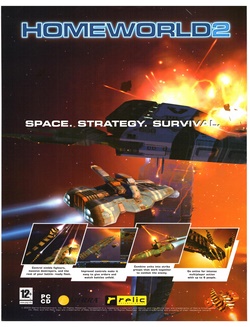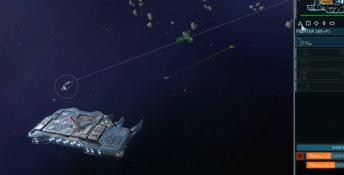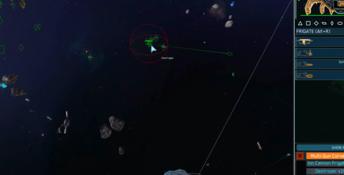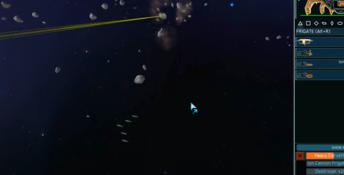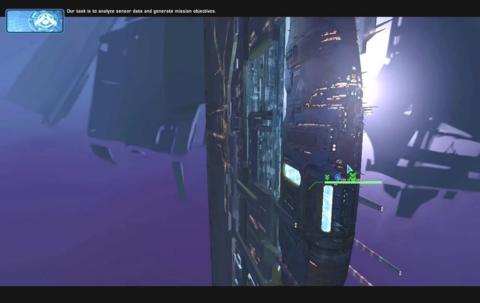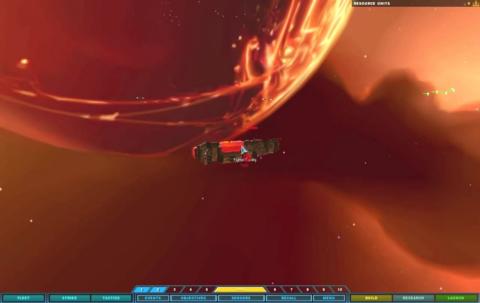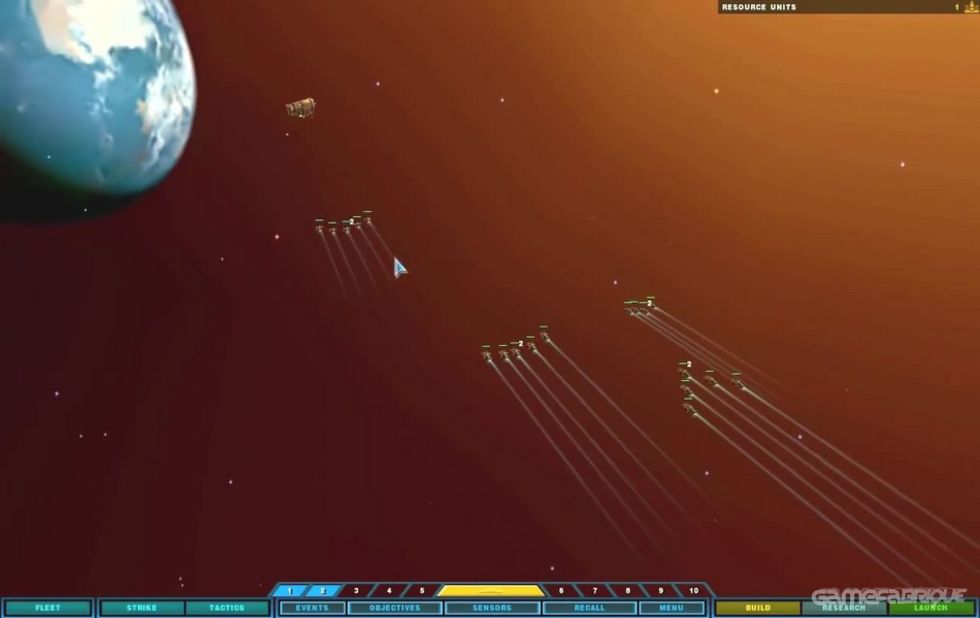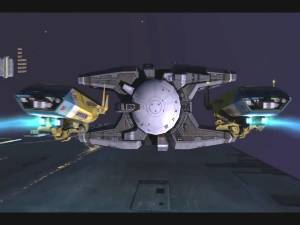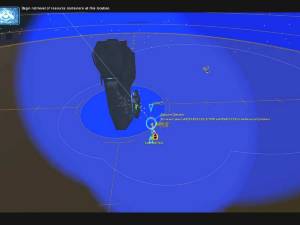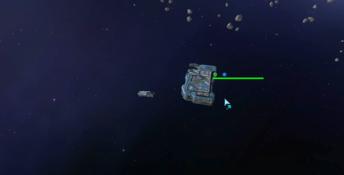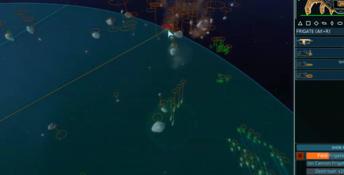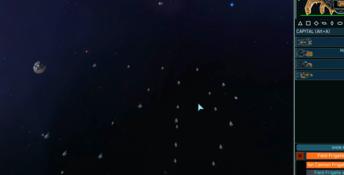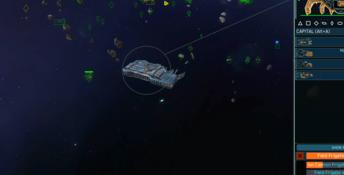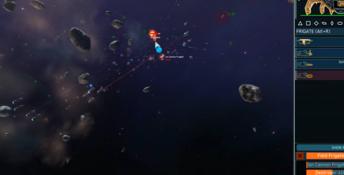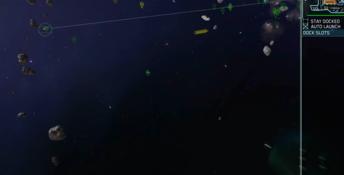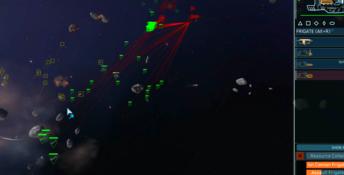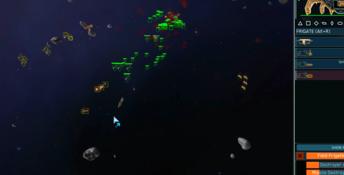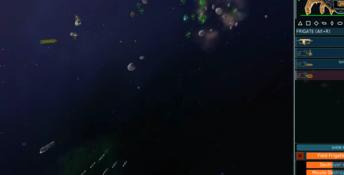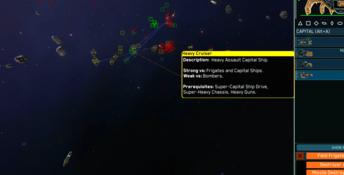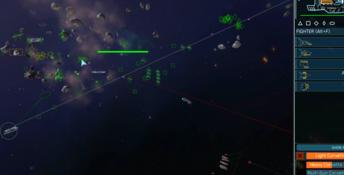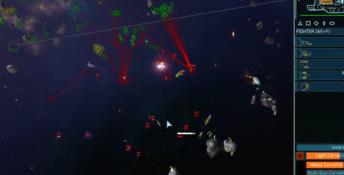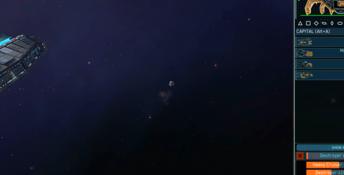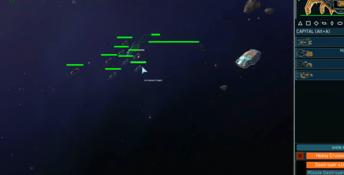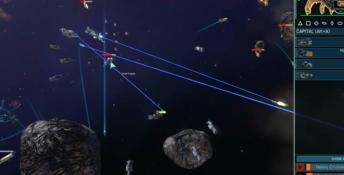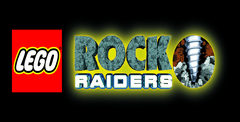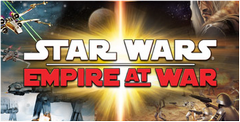Homeworld 2

| a game by | Sierra |
| Platform: | PC |
| Editor Rating: | 9/10, based on 1 review, 4 reviews are shown |
| User Rating: | 7.7/10 - 13 votes |
| Rate this game: | |
| See also: | Download Strategy Games, Best RTS Games, Space Games |
Faux prog rock crackles through my headphones and vapour trails claw across the starfield spread before me. I have sent hundreds of small fighter craft to attack a vast defenceless mothership, laser fire pouring from their cannons, the whole scene reminiscent of some computerised re-enactment of human fertilisation. Sperm flock towards egg, tails flick wildly behind - all to the strains of what sounds like an Ozric Tentacles number. Far out, man.
Before you ask, no I haven't been smoking banana skins. I've been playing Homeworld 2, sequel to Relic's groundbreaking 3D RTS, for longer than common sense deems prudent. And though the version sitting on my hard drive is far from complete, there's enough to give a very good idea of what to expect from the sequel to one of the finest strategy games ever devised.
Galactic Acid
True to plan, the aim of the game is to lead your race from the besieged home planet you fought so hard to find in the original game to salvation among the stars. It's obvious, even after a few minutes play, that Relic has put some considerable effort into telling a good story, as opposed to just ripping it from the opening titles of Battlestar Galactica. Again, the developers have opted to narrate the linear quest with their trademark sketchy cut-scenes, now overlaid with in-engine cinerrjjrtrcs that complement the epic far from spectacular by today's standards, but atmospheric and unhurried nonetheless.
Best Fleet Forward
But it is of course the battles that made Homeworld what it was, and in Homeworld 2 they're just as epic. Hundreds of years have passed since the original tale, so the ships are of course all new, though fulfilling much the same functions. Fighters, bombers, corvettes, frigates, destroyers and capital ships make up the bulk of your fleet, and though there are a few new additions, the general lack of new and unique ships may come as a slight disappointment. Certainly, some of the new craft are quite cool, like the Marine Frigate that allows you to board and capture enemy carriers, but there's nothing on the scale of the biomechanical menace that was introduced in Homeworld: Cataclysm. Let's hope this changes before release.
Where the developer seems to have concentrated most of its attention is on the graphics and user interface. The crude and empty backdrops that Characterised the original game are now replaced by a universe of bright stars, distant planets and ominous gas clouds. The wrecks of long-dead ships litter the galaxy, each offering vital materials to recycle, and often a squadron of enemy interceptors ready to pounce on an unguarded Resource Collector drone.
Warp Nine
Ships offer an impressive amount of detail - the larger craft especially - but it's the sheer numbers of them that's more impressive. Watching hundreds of fighters escorting wings of bombers as they flit about an enemy Carrier, missiles streaming into the unguarded hull - well, it's probably the most impressive sight in sci-fi gaming today. Group your ships into a Strike Fleet and they can progress at the speed of the slowest ship, yet click on an enemy ship and the fastest among them will peel away, while the Missile Cruisers and Ion Frigates will pound away from a distance.
The point is that unlike the original game, you can at last appreciate the scale of the destruction you're inflicting on the enemy, rather than having to master the over-complicated controls and miss the action as a result. Sweeping your view to get a good squint is masterfully simple and though the tactical options are fewer (there's no longer the same wealth of formation options, for instance) the effects are much more pleasing.
Getting into the action is far quicker too. Smaller ships are ready-built into pre-organised wings, so 50 fighters can be built in a matter of minutes, making it far easier to assemble a hasty defence if you see a fleet of frigates approaching your Mothership at speed.
Buffed
On present form, it looks very much like Relic has succeeded in fixing all that was wrong with the original title, while building on the game's obvious strengths. The interface is indescribably better and more streamlined, and while perhaps not offering the wealth of tactical minutiae of Homeworld, it should ultimately make this version all the more enjoyable for veterans, as well as newcomers.
On the downside, there's not all that much in the way of innovation on display - the ships stick to the established template, the resource management seems hardly changed and the research options offer very much the same upgrades as before. Personally, I would have liked to have seen a return of Homeworld's supply system and a multi-map system as seen in Conquest: Frontier Wars, but these are minor quibbles at best.
Ultimately, it's difficult to see many veteran Homeworld fans being upset at the state of this epic sequel. It's lavish in detail, rich in gameplay and hugely atmospheric. And the space battles are among the most magnificent we've ever seen. If, as we suspect, Relic still has a few novel surprises up its sleeve, Homeworld 2 could meet every one of our lofty expectations.
Download Homeworld 2

System requirements:
- PC compatible
- Operating systems: Windows 10/Windows 8/Windows 7/2000/Vista/WinXP
Game Reviews
The Original Homeworld was a game of stunning playability and originality. As well as those cute little glowing trails behind the spacecraft, it took space strategy games to a whole new level by immersing the player in a 3D environment where you could move on both x and y axes. It was a groundbreaking concept that won countless awards, including one for bravery for rescuing a six-year-old boy out of a well. Actually, we could be wrong about that last part. The plot of Homeworld 2 continues pretty much where events left off in HW. After the Taiidan were defeated, the Hiigarans returned to their homeworld with the hyperspace core. There, they began to build a new mothership and, as luck would have it, it's a project they complete just as a new threat known as the Vaygr attacks.
It's at this point the action kicks in with you assuming control of the mothership and whisking it away to safety. From here on in it's off into the big black yonder to find out what the Vaygr want and to then utterly destroy them regardless.
Same Again Please
Emulating the success of HW was never going to be easy. So, in taking the safe option. Relic has decided to keep the gameplay pretty much as it was. The linear, mission-driven plot puts the onus on massive battles against hundreds of whirling fighters and giant dreadnoughts.
In some sense this qualifies HW2 for admission in the 'is this just a glorified expansion pack?' debate. That said, the level of thought and detail that's gone into HW2 is imperious. And we're not just talking about the paint jobs on the fighters or a few rib-shaking explosions -it's the inner workings of the engine that moves the MW universe forward.
Sectioned
HW2 presents a tactical twist on the space combat genre by having spaceships comprisj of various destructible sections. Essentially, the larger a spacecraft, the more destructible components it is made up from.
Take the carriers, for example. Straight out of the factory, they consist of engines at the rear, with the main bulk of the craft up front. But when upgraded, additional nodes like fighter and frigate manufacturing facilities, resource collection modules and more can be bolted on to the shell. The impressive thing about this is that ships do take on individual characteristics both visually and in their attack role. This lets you hone your fleet extensively. You can have twoc class ships - one ing in marine frigate deployment (handy for taking control of enemy vessels) and other for resource collection and repairs. Such attention to detail does have its drawbacks though. Destroying larger craft like the carriers is a tough and complex assignment. Launching bombers and gunships at it until there are so many plasma trails around they merge into one big glowing ball of string is not always the best idea. The most effective method is to target the most important areas first (such as the engines and ship production facilities) and then take the bloody thing to pieces bit by bit. For a seasoned pro this can be a highly rewarding experience, especially when it does finally - and spectacularly - disintegrate and explode in an orgy of pyrotechnical theatre.
If you're not so keen on getting down and dirty with such combat intricacies, things can get confusing and frustrating - not too mention downright bloody irritating. When you've just restarted the mission for the 10th time, and you're still not sure why that Vaygr carrier keeps mysteriously launching fighters at you despite the fact you've just blown away its fighter facility, it's not so easy to go all gooeyeyed over a few fireworks.
HW2 is certainly not for novice strategists. OK, it does feature a tutorial covering all aspects of interface and control, but it never elaborates too much. The lack of a difficulty setting doesn't help either. Like it or not, your choice is hard, hard or hard.
The skirmish mode is slightly more generous. There are three settings from which to choose here, with around 10 maps to try out. And take it from us, the most effective tutorial you can give yourself is to stick around here for a few hours playing on the easy setting. At least you get more time to work things out and see what goodies you can produce - oh, and it's good practice for multiplayer too.
Back in the campaign, free time is unheard of. The Al is cunning and rarely employs rush tactics. Instead, it wears defences down with wave after wave of measured assault. Defensive tactics are just as calculated; it will not hesitate to throw down half a dozen or so heavy gun platforms just to protect its resource collectors.
Wobbly Plasma
Individual ship Al is none too ropey either. On the whole your fleet respond well to situations. Fighters know exactly when to break off an attack on a frigate to engage an incoming fighter threat, and most units will automatically pursue targets if they are close enough. Equally, a destroyer set on defensive stance will not speed towards a lone approaching enemy fighter.
The Al does get a bit bilious when you start targeting individual sections of a ship. On one occasion our squadron of bombers eliminated a carrier's fighter facility and flew straight back to base without attacking the rest of the ship. OK, so their mission was to destroy that particular target, but smarter pilots would have tucked into the engines for good measure.
Unit selection and movement is also unpredictable at times. Moving ships into unoccupied space (and there's a lot of it) can sometimes send them shooting off in the weirdest directions. Using the right mouse button is especially problematic with the developer somehow contriving to place the commands 'rotate camera' and 'move' on the same button. Luckily, if you enter 'sensor' mode, you can zoom out to get a better view of the play area and partially avoid that problem.
One thing you can't avoid is cut-scenes interrupting you when you're in the middle of dragging a movement arrow through space. It wouldn't be so bad if the narrator of these cut-scenes (and the hand-drawn movies between each mission) didn't sound so suicidal. Thank god for the Esc key.
We Just Click
Despite getting occasionally! tangled up with itself, HW2 still possesses tinmost crucial of 'Just One More Go' gameplay qualities. there even comes a time when everything clicks into place. You discover it actually takes surprisingly few bombers to take down a carrier - they just need plenty of fighter escorts; the importance of mobile refineries; understanding the movement interface... Suddenly it all makes sense.
If you can reach that point, then HW2 becomes one of the most thrilling and absorbing strategy games on the PC. Of course, some will dismiss its gameplay as too similar to its predecessor's and we probably wouldn't argue. On the whole though, HW2 has enough ideas, detail and challenging qualities to keep even the deadliest space strategist entertained for a long, long time.
To say we were big fans of Homeworid would be like saying Bill Clinton was a big fan of the internship program. Even though the early screenshots of this full-on sequel make it look like it's been rendered entirely in orange, we've nonetheless started to feel the same sense of giddy excitement that flooded our brain cells with endorphin juice the first time round.
Details of gameplay mechanics are currently rarer than wit in an Adam Sandler film, but what we do know is that Relic has knocked up a brand new engine for the game, overhauling both the look and the interface systems. We've made a ton of improvements, says Alex Garden of Canadian developer Relic, some designed to address concerns we had with the interface in Homeworld, others designed to create new gameplay features that just weren't possible first time round.
Spit And Shine
These include a more streamlined movement system, context sensitive right-click menus, as well as totally overhauled research and construction departments - perhaps the only criticisms we had of the first game.
Along with a phalanx of new ships to play with, the basic mothership designs are getting a touch of spit and shine, visually remaining similar but having their functions beefed up immeasurably. Although you still only get one to play with in the single-player game, multiplayer will open up W distinctively varied motherships I depending on the race. You'll only have two at first, but Garden is promising exciting things" for players after the game ships. Which probably means extra races and missions in an expansion pack.
Visual additions appear to include beefed up Ion lasers that actually slice through their targets (a la Babylon 5), more dynamic looking ship trails that give a better sense of speed, and much more detail on the ship models. For the fanboys, Relic is getting fully into the mod scene this time, promising to provide extensive tools and support for budding amateur coders. For the hippies it's bad news though - 70s prog rockers Yes don't appear to be involved with the music this time. Somehow I think we'll manage.
What Homeworld 2 sadly won't have going for it anymore is the Wow, Crikey' factor, as since the startling debut of the original, practically every space faring developer and his astro dog have nicked the template and added their own twist to it. Relic's own twists will have to once again redefine the genre if it wants to keep its crown. Luckily Relic's other biggie, Impossible Creatures, shows that there's no shortage of innovative thought left at the team, so chances are pretty strong that Homeworld 2 won't just be more of the same only better - it will be just plain better.
It isn't every day that a game will revolutionize a genre but when Homeworld was released, that's exactly what happened. Concepts like introducing a useable Z-axis in addition to great gameplay, graphic, and audio all helped to create a solid and unique experience. Since then however, few have come close to the success of Homeworld with maybe the exception of Hegemonia: Legions of Iron so expectations are rather high that Homeworld 2 will once again deliver a ground breaking performance.
For better or worse however, Homeworld 2 wasn't designed to be ground breaking but to build off the same mold that brought Homeworld its initial success. That isn't to say that different areas weren't overhauled' significant improvements can be found throughout the game. The interface for instance is considerably easier to use and allows for simpler unit movement and tracking, while the graphics offer appreciably more detail even raising PC requirements to higher end units. The first Homeworld also tended to take much longer to finish missions then should have been required. Waiting for units to get to a battle location created problems with game flow that has been resolved in Homeworld 2.
The core of the gameplay still follows the original Homeworld model with a three-dimensional view allowing the ability to rotate the camera to any possible angle. The general objective is also similar as the mothership is once again threatened but instead of trying to reach their home world, this time they are trying to protect it. By collecting resources and strategically building new modules and ships, you'll have to defend and push back this new threat requiring more then sheer numbers.
Although Homeworld 2 won't leave quite the mark its predecessor did, the quality of the game still stands out. With an improved interface, graphics, and other gameplay issues you'll once again find yourself immersed trying to defend the Mothership and the home world.
